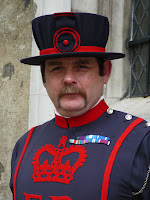ENGLAND'S HISTORIC TOWER OF LONDON
Our destination that day was the 900 year old Tower of London, England’s top tourist attraction drawing more than 2 ½ million visitors annually.
Passing through entrance gates into the medieval fortress we were confronted by two huge beady-eyed ravens, their feathers gleaming with an irridescent sheen as they crab-walked across the cobbles.
The Tower of London's resident ravens
Legend has it that should the ravens ever leave, both the Tower and the country will fall. Thus for centuries six resident birds have patrolled the grounds. Because they haughtily rebuff any friendly overtures with a sharp nip to the fingers, the birds are treated with respect by wardens and tourists alike. They reside in their own lodgings, are given a weekly ration of horsemeat, have their own cemetery in the Tower moat and are watched over by a personal carer, a Yeoman Warder known as the Ravenmaster.
 |
| Yeoman of the Guard |
Accompanied by Yeoman Warders (also known as Beefeaters) grandly costumed in elaborately embroidered red and black outfits and wearing black velvet Tudor bonnets, visitors are taken on tours to the White Tower, Bloody Tower, Traitor’s Gate and the chopping block where guides describe in gory detail many a royal execution.
According to our guide, the ghost of Anne Boleyn, Henry VIII’s second wife, is sometimes seen in the environs of Queen’s House where she was incarcerated before her beheading.
Captive in the Tower of London
For me, the prime draw-card in this fascinating place was, without a doubt, the Jewel House. Once within its impregnable confines rules are strictly enforced. When I stopped to gaze at the Imperial State Crown, its diamonds, rubies and sapphires twinkling like something out of fairyland, a sharp “No stopping please” jerked me back to reality. To lean too heavily on the glass brings about an even more embarrassing incident. Just the slightest pressure activates the slamming of the vault’s massive steel doors holding everyone captive inside until a suitable explanation has been offered.
After gazing upon all that opulent magnificence the object that stirred a feeling of magic in me more than any other, was the delicate beauty of the tiny diamond crown worn by Queen Victoria as a child.
At 10 p.m. each evening when most other tourists have headed wearily back to their lodgings, there is one final experience that is not to be missed.
The Tower's Ceremony of the Keys
Nightly for the last 700 years, the ritual securing of the Tower has taken place in the form of the ‘Ceremony of the Keys’.
At 9.53 p.m. the Chief Yeoman Warder carrying an impressive bunch of keys and accompanied by a military guard of four, sets out to lock all the entrance doors to the Tower. As they pass the Bloody Tower which once housed two young princes who were brutally murdered, all sentries present arms. When they return seven minutes later they are challenged by the sentry with the words:
"Halt, Who comes there?"
"The Keys," replies the Yeoman Warder.
"Whose keys?"
"Queen Elizabeth’s Keys. "
"Pass, Queen Elizabeth’s Keys. All’s well."
Given permission to proceed, the Chief Yeoman Warder lifts his bonnet and in a clear strong voice cries out "God preserve Queen Elizabeth".
At that moment the clock strikes 10. A soldier raises his trumpet to his lips and the plaintive notes of The Last Post float across the green echoing eerily in the stone battlements of England’s famous Tower of London and out across the Thames.
Posted by Anne Gordon on Friday 22nd October, 2010



0 Comments:
Post a Comment
Subscribe to Post Comments [Atom]
<< Home